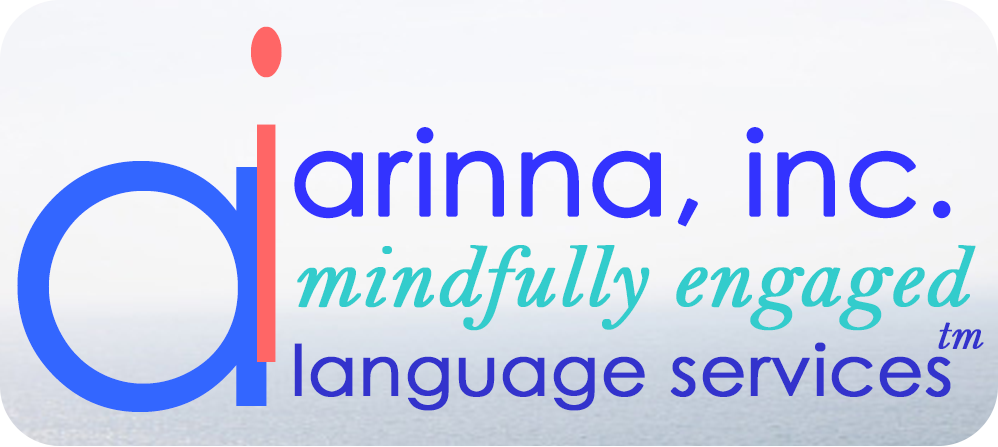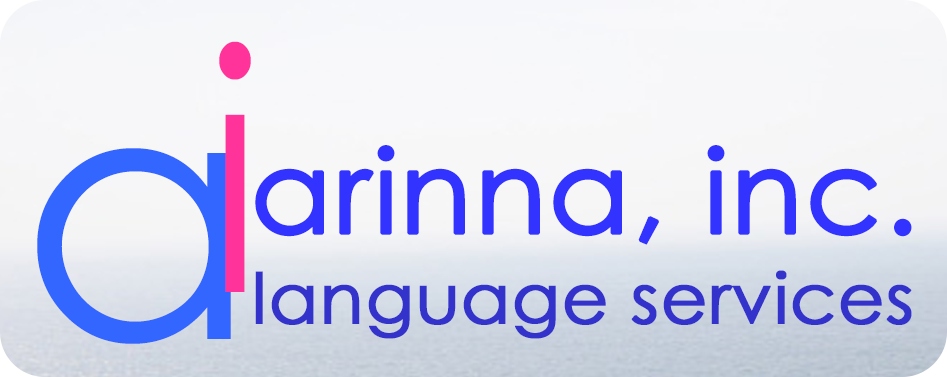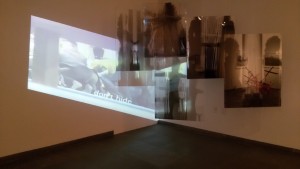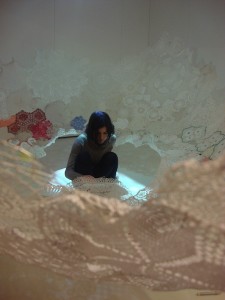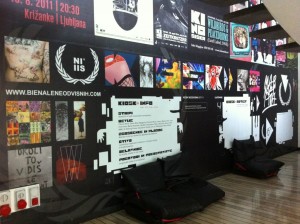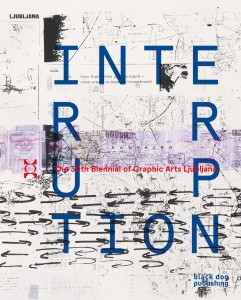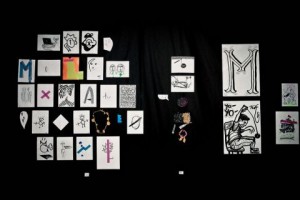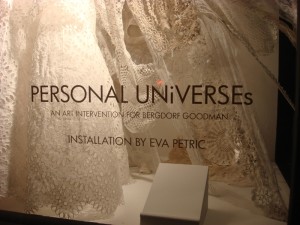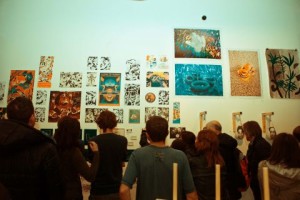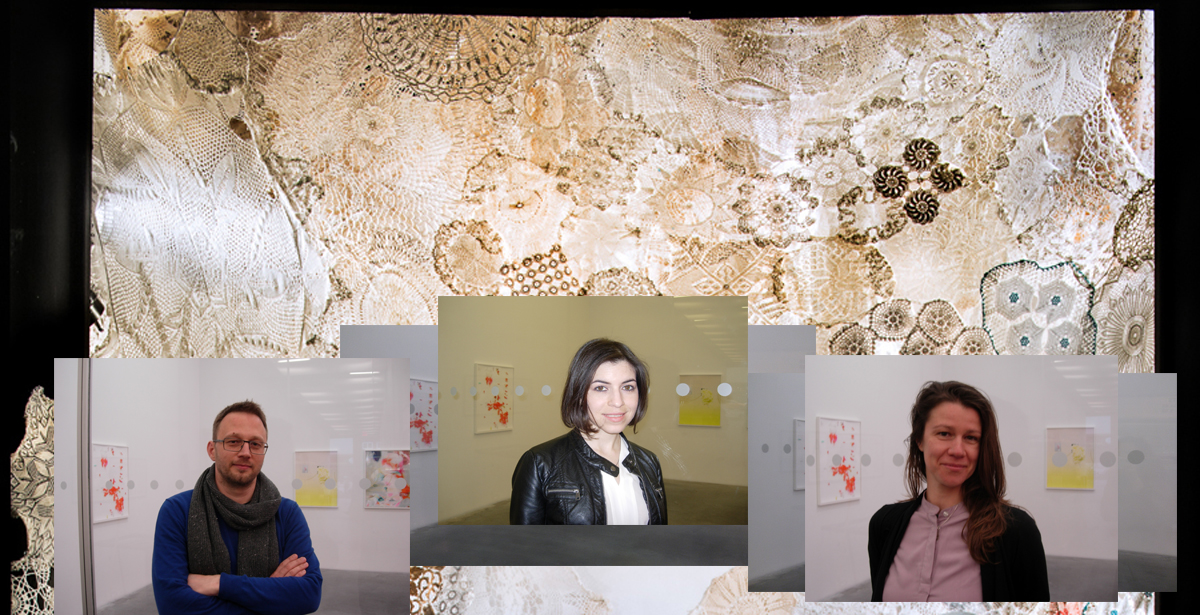
Božidar Zrinski (curator), Eva Petrič (artist), and Irena Silić (art manager) at the New Museum’s Hester Street Café, Bowery, NYC. The background image is from the installation by Eva Petrič at Bergdorf Goodman, NYC.
I’ve always had an uneasy rapport with contemporary art. I understand it intellectually, but I miss a more organic and deeper connection. Art through the end of 19th century has smooth canvas surfaces. Impressionists, pointillists, expressionists began breaking the continuity of paint, and the deconstruction continues. But what happens after deconstruction? We cannot just stay in the fragmented state.
As part of my daily errands, I walk by the New Museum that opened a few years ago on the Bowery in Manhattan. But I never went in; it made me feel uncomfortable. When I was choosing a place to meet with the Slovene artist Eva Petrič, art manager Irena Silić, and curator Božidar Zrinski for the interview, I said that I must experience this space if I am to write about contemporary visual art. I entered and felt oddly comfortable: there was more human, organic flow to the environment than I expected. As I was sitting at the Hester Street Café, housed at the New Museum, looking through the glass wall at the exhibited art, it dawned on me. The contemporary art is all about collages, about creating a new composition out of torn pieces, broken layers.
Contemporary art is all about collages. It represents how we live. (M.Stemberger) #SloConnect Share on X
If we observe how we live at the beginning of the 21st century, we notice decomposition into particles and stratification into layers. There are odd shadows and messy debris. But we have the opportunity to connect these broken pieces around us in a new way. We continuously construct our own individual multi-layered mosaics from the text and visual information we grasp on the internet. All of a sudden, I found it easier to comprehend contemporary art: it does represent how we live after all.
Layers, Shadows, Laces
Božidar Zrinski, Curator at the International Center for Graphic Arts, Ljubljana:
Today’s international society, in which we live and which surrounds us all the time, is characterized by constant information, good and bad, useful and useless. Some informational landscape has always been present, and artists were aware of it since Pop Art, or even earlier. Many have tried to find their position in this completely fragmented and information rich environment. Some have somewhat leaned onto tradition and their surroundings. Many younger artists in Slovenia, however, no longer associate with an artistic tradition but try to transfer the daily information surplus into their work. I’d dare say that they are very good, not lacking cultural broadness. Sašo Vrabič, Katja Felle, Marko Batista, BridA, Špela Petrič, for example, could easily be part of the current Triennial at the New Museum.
Eva Petrič, Slovene Multi-disciplinary Artist, Ljubljana, Vienna, NYC (www.evapetric.com):
Our way of life is marked by many beginnings and endings, new beginnings. People are constantly undertaking new ideas, new projects. This certainly affects contemporary artworks. And mine as well: they can all be seen as collages.
I’m working with photography, but for me the photos are like letters that I assemble into images. I enjoy the most when working with installations where people themselves can move, where there are layers, shadows, artistic, cultural works.
The more we develop, the more we become aware of what exists around us, but also inside of us. On the one side, we are more individualistic, we have a stronger I. At the same time, we must exist in a larger structure, in a collage. Lace is a good example. On a micro level, it represents a pattern, how we are structured: our vascular and nerve systems. On the macro level, we have stars. Lace is such a universal pattern, which I think will be seen more and more.
Lace is such a universal pattern, which I think will be seen more and more. (E.Petrič) #SloConnect Share on X
Marta Stemberger: While we have our own Idrija laces in Slovenia, the laces appear in almost all cultures around the world in various ways.
Eva Petrič: Yes, to me they are an artistic form. I think art is always a reflection of something real in a more abstract way, and can stand in for many things. A lace is one line, a thread that connects point A with point B, creates a relation.
Marta Stemberger: That’s how it’s made. There are bobbins, pins, threads interweaving. It’s like many people creating a pattern together.
Eva Petrič: There are infinite possibilities.
Marta Stemberger: And interpretations.
I find this as another proof that lace—what it represents and how it’s made—is not a negligible thing.
Art is always a reflection of something real in a more abstract way. (E.Petrič) #SloConnect Share on X
Marta Stemberger: This is another reincarnation of your art intervention “Personal UNiVERSEs”, which was on view at the Bergdorf Goodman windows in February through March 8 this year. The first one was presented HEMA- TOMA in 2011 at Centro Cultural Borges in Buenos Aires, Argentina, and then also in April 2014 as “IN-between-SPACE” at the Burgkapelle of the Museum for Contemporary Art Carinthia, Austria.
Eva Petrič: Yes, it’s envisioned as a traveling exhibition that moves to various locations and transforms due to different places, depending how the space functions and affects the artwork.
Why New York
Marta Stemberger: Eva, you had two of your works shown in New York City this year. Why does this city attract you?
Eva Petrič: New York was in a way an artistic seal in my life. I lived in New York for 2.5 years; I finished my high school at the United Nations International School where I turned more towards visual art.
Marta Stemberger: You lived in many big cities, but New York is probably still the most culturally diverse.
Eva Petrič: Yes, I think so. There’s motivation and co-habitation. People come here because they want to work and succeed. Perhaps they don’t come to stay, but they want to achieve something and leave, so they spend their time the most productively. It’s different from other cities, and gives this city some charge, energy, which always affects me in a very positive way.
At the same time, there’s co-habitation. Everyone is aware that they are in a small space, in a melting pot. If they don’t respect each other, they won’t be able to survive.
Marta Stemberger: Irena, you came to New York through the association Tretaroka, including Saša Kerkoš, Barbara Poček, Piera Ravnikar, who were in Brooklyn residence this January. The group is involved with the organization of the Slovene Biennial of Independent Illustration. Why New York, and not London, Berlin, or Vienna?
Irena Silić, Art Manager for the Slovene Association Tretaroka, Ljubljana:
New York is in principal very open to more avant-garde, non-institutionalized projects. And you get a very quick feedback to an idea. Connections, partially personal, partially professional, can happen quicker. I believe that a good idea can be realized faster here, if in the right hands.
As a group, we were looking for a space that was global and local at the same time. When you start in New York, you are daily meeting people from all over the world. By making a genuine contact with someone, a road to their country can open as well. You never know where it will take you. When you start with a project, you never know the outcome. Often ideas began to be forged while you are in conversation—something creative comes out, information about application calls, NGOs—and you can start minting.
When you start with a project, you never know the outcome. (I.Silić) #SloConnect Share on X
Marta Stemberger: Irena, you are experiencing New York as an art manager for a small independent alternative group. Božo, you are a curator for an established Slovenian art institution. You choose New York for your one-month residency in Brooklyn as well.
Božidar Zrinski: New York has a very high-level multi-layered contemporary graphic art scene. One can see high-end artistic production in the studios as well as underground production of some independent groups, and also street production.
Marta Stemberger: You don’t have that in London or Berlin?
Božidar Zrinski: You do, but New York is different. Each city has its own characteristics, its own perspective. In the last few years—especially through Deborah Cullen, a New Yorker who curated the last Ljubljana’s International Biennial of Graphic Arts, 2013—I met many artists who live and work here, and also many professionals who are working with graphic arts in the studios. Maria Elena Gonzalez—who won the Grand Prize at the 30th Biennial, and later had an independent exhibition at our Center for Graphic Arts—also lives in New York, as well as San Francisco.
Marta Stemberger: You are involved with the well recognized International Biennial of Graphic Arts in Ljubljana. Through your work, you get in contact with American artists who then come to exhibit in Slovenia. You don’t necessarily work to place Slovene artists in the U.S.
Božidar Zrinski: Yes, but you never know how it will turn out. The communication may be very one-sided, but can also develop into a two-sided one. Yet, it’s still much easier to bring a foreign artist to Slovenia than it is to “export” a quality Slovene artist abroad. Mainly because it’s hard to find a partner on the other side. Slovene institutions—museums, galleries—act as a partner if someone wants to bring in an artist, and also make an effort to get some known foreign artist to visit. Our task is to provide high-quality venues for the visiting artists.
The “export” of Slovene culture depends on the connections one has abroad. (B.Zrinski) #SloConnect Share on X
But when it comes to the Slovene culture “export”, it very much depends on the connections that an individual or a gallery has in a foreign country. If these are on a high and well-known level, then the realization is a little easier. Yet, all these acquaintances that we have, that I have personally, don’t mean that it’s easier to bring our culture abroad. There are requirements, mainly of financial nature, when Slovene artists or managers work overseas. The response is often: ‘You can come, we’ll give you space, but you need to get everything else together, money, travel.’ Whereas the other way around is different: Slovenia strives to keep the contact with the world artistic production, which it does fairly well, but must often pay for many things.
Foreign artists who visit, have an additional incentive from various cultural institutions, associations, national foundations that can help them. We don’t have such resources for our own artists. Whoever organizes any exhibition abroad and would like to get additional funds, has to turn to a Slovene cultural institution. So at the end, all goes to the Ministry of Culture where the selection is made. The requests are many, and it’s difficult to assess which artwork is of the highest importance. Each exposure of a Slovene artist across our borders counts.
Each exposure of a Slovene artist across our borders counts. (B.Zrinski) #SloConnect Share on X
The responses we get from the professional public in New York are very positive. Sometimes one is surprised that a person knows the Ljubljana International Biennial of Graphic Arts, and even has its catalogs. Yet, it’s difficult to make the breakthrough, so that our authors and artists would have a direct benefit from these positive reactions.
What a Curator Does
Marta Stemberger: It seems that it also depends on choices the curators are making. What is involved in a curator’s work?
Božidar Zrinski: In a way, a curator’s work happens on three levels. At one level, one needs to constantly follow—with some personal sensibility—what is happening, trying to find what will emerge, or what is currently on the surface, that may be interesting to present. Or, one might be interested in a very specific problem, tries to develop a concept, and answers with artists and their work. The third approach is to constantly follow the artistic production and try to identify some critical points that appear in many artists’ work, and show that at an exhibition.
Marta Stemberger: So the curator’s work does not consist of organization alone, but also of an artistic component. If a curator has an idea or develops a concept, s/he then selects artists based on this idea or concept to show at an exhibition. Thus a curator, in a way creates a new art space, or even a new temporary artwork by how s/he interweaves the selected artists.
Božidar Zrinski: I’d be very careful here, I wouldn’t go that far. I don’t consider myself an artist, and I don’t want to become one. If a curator positions her/his idea as the main one then the artworks become only an illustration. This creates circumstances that I don’t see as the most optimal. I find it better to try to create conditions for things to happen, for an exhibition to happen. As a curator, one tries to find the most optimal way with all the support for the artist and their work, by critically thinking about the art’s content.
Marta Stemberger: It’s more about holding space then?
Božidar Zrinski: One senses a different platform where something can happen. But I don’t see this as artistic.
Irena Silić: Not like an artist. I love art, I like to be part of it, but I stand on the other side, connected through art management.
Marta Stemberger: But it’s creative?
Irena Silić: It’s creative in a sense to search for, see, create new opportunities, connections, events. It’s about the creation of a new space where the artists can present themselves.
Božidar Zrinski: Yes, that’s it. I think that there aren’t enough initiatives such as the Biennial of Independent Illustration.
Horizontal and Vertical Layering
Marta Stemberger: The Slovene Biennial of Independent Illustration is a “creative platform supporting direct authorship, horizontal selection and no censorship of work, established in Ljubljana, Slovenia in 2007”, says on your website.
Irena Silić: We are a small group of creative individuals, organizing various art events through a non-governmental organization Tretaroka. We are about art and design. We are linking art with socially engaged projects to change some established ways of curating and artistic practice. We want to build a biennial platform as a global umbrella to create wider social projects in connection with art, and make a social input in local communities.
It's about creation of a new space where artists can present themselves. (I.Silić) #SloConnect Share on X
Marta Stemberger: You work in a different environment.
Irena Silić: We are underground where there are no institutions, only associations. We are financed by the Slovene Ministry of Culture and some smaller organizations. Here in the U.S., we were exploring NGOs that work with themes that are of interest to us. These are mainly very small non-profits, funded from private sources. It’s mostly voluntary help, based on empathy for artistic change.
We were working in the Bronx were nothing is happening, yet, things are moving in the background. Our main idea is to map the artists who are not yet recognized on the mass art market that exists in New York; they may not have yet had a chance to be recognized. It’s about mapping of the Bronx artists who are located and active in the Bronx, and through their work engage the local community to overcome certain issues that still prevail in the Bronx. The project consists of an openly shared online map. We support open source, open sharing of knowledge.
We support open source, open sharing of knowledge. (I.Silić) #SloConnect Share on X
Marta Stemberger: You are trying to find different ways to engage and connect people who are left in the shadows of social and artistic layering, so that a different tapestry can emerge. Yet, at the same time, you are still vertically connected through the layers because of your funding from the Slovene Ministry of Culture, which, as you mentioned, is a blessing, but also creates limitations.
Božidar Zrinski: Yet, one can create a way of working so that some very wild or weird ideas can be realized even within an institution. I was lucky to show the exhibitions of graffiti art and street art with important Slovene artists Zek Crew, Joke42, Ash, who co-created the whole scene. These two exhibitions are still mentioned very often. Ten years ago, we succeeded to identify a very hot content and creative spot, something that was really ready to emerge. The question was only how. With the street art show, the idea was to mix Slovene and foreign artists, and perhaps something would come out of it. This is a particularly alive creative public who easily finds familiar connections. I think we succeeded fairly well: some projects emerged, even with the foreign artists in Ljubljana.
Later, at a higher level of the Biennial in 2009, we presented the American group JustSeeds, an independent, underground creative collective with interesting socially critical output. They even won the Grand Prize, and had independent exhibition in 2011.
As a curator one never knows what the outcome will be. (B.Zrinski) #SloConnect Share on X
However, I’m looking back critically from the perspective that after these two exhibitions, the street production among our youth stopped, or transformed to other areas, perhaps even to the Biennial of Independent Illustration. It seems that we satisfied expectations of some circles, and then the field was dead. I think that perhaps we assisted this decline. As a curator one never knows what the outcome will be.
Weaving a Global Net of Slovene Art
Slovenian institutions invite foreign artists and curators. But who invites Slovenian artists, or even curators? It seems that Slovene artists are mainly left to their own devices and initiatives.
Tretaroka is another example of ingenuity and persistence. When visiting the U.S., Irena and her colleagues presented their work—from Slovene Biennial of Independent Illustration to Design Biotop to LIMITED EDIT111ONS to Independent Platform—at various levels, and the feedback was very positive: “People in New York find it great because it’s creative and it moves boundaries, breaks production stereotypes.”
Tretaroka is actively looking for presenters and venues, says Irena: “I’m trying to find ways for this exhibition to travel to other locations in the U.S.”
Where are American or Slovene American organizations that would invite Slovene visual artists?
While there are some non-profits that promote a more balanced exchange between the U.S. and South East Slavic countries, like CEC Artslink or Gallery MC, the artists still need to hustle their own connections. Yes, some Slovene galleries promote their charges abroad. But even the Slovene artist Mik Simčič is at the current ArtExpo 2015, NYC, through his own Gallery 56. Well, Slovene independent gallery structure is still being formed.
Slovenia has a vibrant art scene, especially in Ljubljana, the capital. This autumn, two important biennials will take place: The 31st International Biennial of Graphic Arts, opens at the end of August, and the 5th Biennial of Slovene Independent Illustration, opens at the beginning of November.
Artists and curators are open for connections. Some curators who work at Slovene art institutions as public workers, like Božidar Zrinski, are open to share their expertise and experience about Slovene contemporary art.
Ideas need to be shared to inspire fresh solutions. (M.Stemberger) #SloConnect Share on X
We all need to engage in creative activities. But some people reach deeper, and we call them artists. To some extent it’s good for artists to be proactive in establishing connections and promoting their own work. Yet, a vibrant art scene also requires a wider and stronger engagement by the presenters and partners who can offer professional support within the art markets. Artists would welcome galleries and curators who would actively seek out and exhibit their work.
A larger art environment has to embrace the artists and their art for the ideas to have an impact; the exchange cannot happen in isolation. The cultural and artistic exchange is crucial. Ideas need to be shared to interpenetrate, to cross-pollinate. This enables new layers to emerge, facilitates creation of new patterns.
If the artists are forced to become expert art managers and promoters of their own artworks, they won’t have proper time and energy to engage in creation of their art. And we all get deprived of different pieces for the multi-faceted puzzle of human artistic experience. We need a more meaningful human tapestry that may inspire new ideas, offer fresh solutions. Art is essential for human development. As Matthew Fox wrote: Artists “make life come alive for…all of us.”
